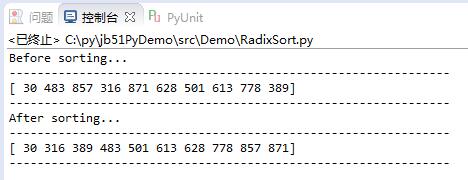本文实例讲述了Python实现的基数排序算法。分享给大家供大家参考,具体如下:
基数排序(radix sort)属于“分配式排序”(distribution sort),又称“桶子法”(bucket sort)或bin sort,顾名思义,它是透过键值的部份资讯,将要排序的元素分配至某些“桶”中,藉以达到排序的作用,基数排序法是属于稳定性的排序,其时间复杂度为O (nlog(r)m),其中r为所采取的基数,而m为堆数,在某些时候,基数排序法的效率高于其它的稳定性排序法。
实现代码如下:
|
1
2
3
4
5
6
7
8
9
10
11
12
13
14
15
16
17
18
19
20
21
22
23
24
25
26
27
28
29
30
31
32
33
|
#-*- coding: UTF-8 -*-import numpy as npdef RadixSort(a): i = 0 #初始为个位排序 n = 1 #最小的位数置为1(包含0) max = np.max(a) #得到带排序数组中最大数 while max/(10**n) > 0: #得到最大数是几位数 n += 1 while i < n: bucket = {} #用字典构建桶 for x in xrange(0,10): bucket.setdefault(x, []) #将每个桶置空 for x in a: #对每一位进行排序 radix =(x / (10**i)) % 10 #得到每位的基数 bucket[radix].append(x) #将对应的数组元素加入到相应位基数的桶中 j = 0 for k in xrange(0, 10): if len(bucket[k]) != 0: #若桶不为空 for y in bucket[k]: #将该桶中每个元素 a[j] = y #放回到数组中 j += 1 i += 1if __name__ == '__main__': a = np.random.randint(0, 1000, size = 10) print "Before sorting..." print "---------------------------------------------------------------" print a print "---------------------------------------------------------------" RadixSort(a) print "After sorting..." print "---------------------------------------------------------------" print a print "---------------------------------------------------------------" |
运行结果:

希望本文所述对大家Python程序设计有所帮助。
原文链接:http://www.cnblogs.com/biaoyu/p/4831648.html










